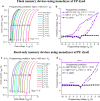Advanced Nonvolatile Organic Optical Memory Using Self-Assembled Monolayers of Porphyrin-Fullerene Dyads
- PMID: 35343673
- PMCID: PMC8990517
- DOI: 10.1021/acsami.1c24979
Advanced Nonvolatile Organic Optical Memory Using Self-Assembled Monolayers of Porphyrin-Fullerene Dyads
Abstract
Photo-switchable organic field-effect transistors (OFETs) represent an important platform for designing memory devices for a diverse array of products including security (brand-protection, copy-protection, keyless entry, etc.), credit cards, tickets, and multiple wearable organic electronics applications. Herein, we present a new concept by introducing self-assembled monolayers of donor-acceptor porphyrin-fullerene dyads as light-responsive triggers modulating the electrical characteristics of OFETs and thus pave the way to the development of advanced nonvolatile optical memory. The devices demonstrated wide memory windows, high programming speeds, and long retention times. Furthermore, we show a remarkable effect of the orientation of the fullerene-polymer dyads at the dielectric/semiconductor interface on the device behavior. In particular, the dyads anchored to the dielectric by the porphyrin part induced a reversible photoelectrical switching of OFETs, which is characteristic of flash memory elements. On the contrary, the devices utilizing the dyad anchored by the fullerene moiety demonstrated irreversible switching, thus operating as read-only memory (ROM). A mechanism explaining this behavior is proposed using theoretical DFT calculations. The results suggest the possibility of revisiting hundreds of known donor-acceptor dyads designed previously for artificial photosynthesis or other purposes as versatile optical triggers in advanced OFET-based multibit memory devices for emerging electronic applications.
Keywords: OFETs; optical memory; organic field-effect transistors; photoswitching; porphyrin−fullerene dyad; self-assembled monolayer.
Conflict of interest statement
The authors declare no competing financial interest.
Figures





References
-
- Imahori H.; Fukuzumi S. Porphyrin- and Fullerene-Based Molecular Photovoltaic Devices. Adv. Funct. Mater. 2004, 14 (6), 525–536. 10.1002/adfm.200305172. - DOI
LinkOut - more resources
Full Text Sources

